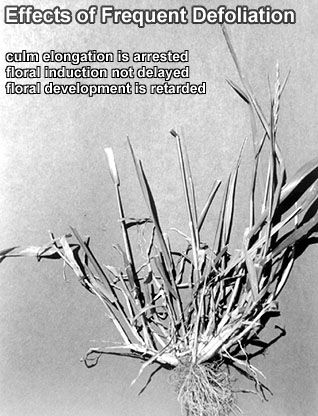How grass grows is only part of the secret to better management. Grasses can be most productive when clipped by mowers or bitten by animals. The word defoliation comes from "folium," Latin for leaves. So the word itself is a great reminder that leaves are the primary target when harvesting grass. And the term defoliation assumes those leaves will be removed prematurely (not as a result of death).
Defoliation can be productive or destructive. There are several areas where plants grow (roots, leaves, culm, rhizomes, stolons, and crown). But regrowth from the leaves is most important for efficient regrowth after defoliation. For optimal regrowth following defoliation there must be cell division and expansion in certain meristem systems. Knowledge about the location and specific function of these meristems is critical for successful forage management.
1. Apical meristem: the apex (primordium, growing point) of a shoot or tiller eventually produces leaves, stems, and seed heads.
2. Intercalary meristem: located where a leaf blade (lamina) joins the sheath, represents the collar of a grass plant. The intercalary meristem accounts for the increasing length of leaves and sheaths.
3. Shoot or tiller: a cylindrical bundle of relatively immature leaf blades enclosed by sheaths or more mature leaves. Leaves are formed from successive layers of cells in the apical meristem.
4. Basal buds: shoot initials in crown tissues which develop into new tillers (recovery growth) when defoliation destroys the growing point of the "mother" shoot.
Successful regrowth after defoliation will depend on productive meristem systems.
